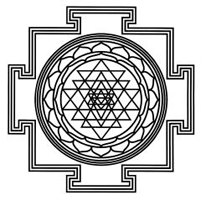Tantra may also use geometrical devices as the object of meditation or concentration. These objects are yantras, and can be considered visual mantras. The yantra is a representation of the universe, and its contemplation leads to realizations about the universe’s nature. The word yantra literally means a machine or device. While a yantra is similar to a mandala, the yantra is square and contains interlocking triangles. A mandala, however, can be of various shapes.
The Shri Yantra contains five downward-pointing triangles representing Shakti, and four upward-facing triangles representing Shiva. [1] Together these nine triangles form forty-three individual triangles. Toward the outside are found two circles of lotus petals. The inner eight petals represent Vishnu, and the outer sixteen petals represent the attainment of the desired object. Vishnu’s consort is Lakshmi, who is also known as Shri. She is the goddess of good fortune, and it is after her that this yantra is named.
At the center of the yantra is a dot, called a “bindu” or seed point. This is the focal point. In this one infinitely small point is found the infinitely large universe. Whatever exists outside is found inside, and vice versa. This single realization is at the core of many religious esoteric teachings. The macrocosm is a reflection of the inner microcosm, and what happens in one realm affects the other.

The practice of yantra visualization is not easy, and its mastery depends upon the student’s power of concentration and her ability to feel and control the subtle energies. Tantra also employs visualization of a chosen deity. Similar to a yantra, the objective of this practice is to completely identify with the form being visualized. Every nuance should be experienced completely, especially when the eyes are closed.
The use of mantra, yantra, and mudras are far from the only, or even the most well known, forms of Tantra practice. Of more notoriety are the Pancha-Makara: the Five-M’s.
(Next: The Pancha-Makara of Tantra )
